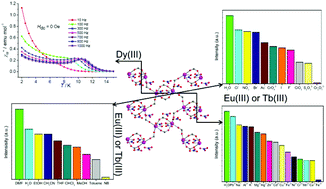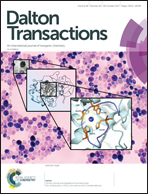2D carboxylate-bridged LnIII coordination polymers: displaying slow magnetic relaxation and luminescence properties in the detection of Fe3+, Cr2O72− and nitrobenzene†
Abstract
Eight new 2D isostructural lanthanide coordination polymers (Ln-CPs), [Ln(HL)(H2O)2(NO3)]·NO3 (1-Ln), Ln = NdIII, SmIII, EuIII, GdIII, TbIII, DyIII, HoIII, and YbIII ions, H2L = 4-(3,5-dicarboxylphenyl)-2-methylpyridine, were synthesized by using solvothermal methods and studied by structural analyses, magnetic analyses and luminescent probes. Crystallographic studies revealed that these compounds are 2D frameworks in which dinuclear units with double μ-syn,syn-carboxylate bridges are interlinked by single μ-trans,trans-carboxylate bridges from organic spacers. The layers are further stabilized and combined into 3D architectures through intra- and interlayer π⋯π stacking interactions and hydrogen bonding, respectively. Magnetic investigations indicated that the carboxylate bridges transmit intralayer antiferromagnetic coupling in 1-Nd, 1-Gd and 1-Ho but transmit intralayer ferromagnetic coupling in 1-Dy. Furthermore, 1-Dy also displays slow magnetic relaxation behavior with a high relaxation energy barrier (ΔUeff) of 100.7 K and a pre-exponential factor (τ0) of 1.4 × 10−8 s under zero dc field. The luminescence investigations showed that CPs 1-Eu and 1-Tb can serve as highly selective and recyclable sensing materials for Fe3+, Cr2O72− and nitrobenzene. Thus, both 1-Eu and 1-Tb should be excellent candidates for multifunctional sensors.



 Please wait while we load your content...
Please wait while we load your content...